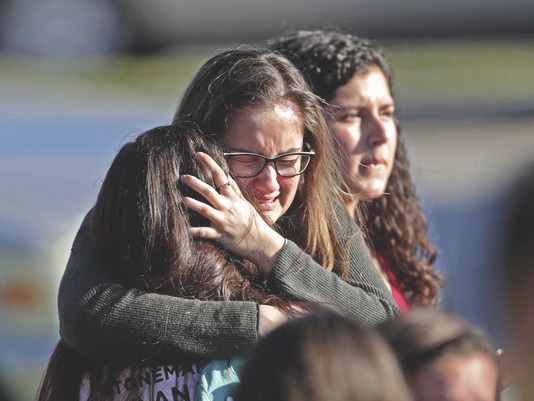
I was on the phone discussing a provocative story about the Jewish holiday of Purim when news of the Parkland, Fla., school massacre first broke. At the time, it was just “a shooting.” No one knew yet the extent of the tragedy. My phone conversation was barely interrupted.
Within a few hours, everything had changed. As news of the casualties kept dribbling out, my mind raced. This was the afternoon of Feb. 14. Our paper had gone to print a day earlier with a cover story on the looming crisis in Syria. What a shame, I thought, that we couldn’t have a story on Parkland while it was on everyone’s mind. That is the foible of print — you’re at the mercy of fate and the printer’s deadline. Well, if we couldn’t be topical, I said to myself, at least we could go deeper into the story for the next print edition.
In the meantime, there’s always online.
We quickly posted the story on our website and started planning the next print edition. Because our cover is glossy and needs to go to print earlier, we had to decide pretty quickly on a cover design. I recalled this haunting visual from our cartoonist Steve Greenberg showing a map of America delineated by guns. We went with that image, and a line that seemed to capture the mood of the moment — “When will it end?”
The issue of gun violence in America is so fraught with emotion and complexity we decided to get community reactions from a variety of voices. Senior reporter Danielle Berrin and I drew up a preliminary list to get diverse views. I also called our political editor in Israel, Shmuel Rosner, to see if he could connect us with an Israeli security expert who could share the Israeli perspective. He connected us to Oded Raz, whom we interviewed for our back-page Q-and-A. It’s worth reading what he has to say, especially about strategies to protect American schools from shootings.
On Friday afternoon, we got a lead on the Chabad rabbi in Parkland whose office is minutes from the shooting and who jumped into the chaos of the tragedy. We interviewed him on Saturday night and posted the story online the following morning. On Feb. 19, I heard that a Los Angeles rabbi, Shlomo Einhorn, had flown to Parkland with a few students to make shivah calls, and I asked him to write about it. You can read about his experience in the “columnist” section. All along, we had to juggle how to fit everything in with our regular coverage.
It wasn’t until Sunday, when I saw a heart-rending image of two mothers crying in Parkland, that it hit me — my heart had deadened since the news broke. I had become numb. Instead of feeling the unspeakable pain that had been unleashed on a community, I was thinking of how best to cover the story. I felt an odd, quiet shame: How could I be so callous? I reflected on the cold-bloodedness of a profession that leaves little room for emotion when a major story strikes.
Violence that destroys human lives triggers deep emotions, and anger is one of our deepest. When that violence keeps repeating — as with terror attacks in Israel or mass shootings in America — our anger becomes an emotional reflex.
And then I thought: Am I the only one? Was my absence of grieving only due to my profession?
I wasn’t a journalist when a terrorist plane struck the first of the twin towers on Sept. 11, 2001. As this mass of glass and steel crumbled to earth, I thought: Maybe now the world will better understand what Israel is facing. What a narrow-minded reaction: Couldn’t I find one minute to grieve for the victims? But I was enraged at the terrorists — that was my primary reaction.
Maybe this is human nature and I shouldn’t be so hard on myself. Violence that destroys human lives triggers deep emotions, and anger is one of our deepest. When that violence keeps repeating — as with terror attacks in Israel or mass shootings in America — our anger becomes an emotional reflex. This anger only grows as the story unfolds: How could we allow an unstable person to buy a semi-automatic rifle? How could the FBI and local authorities fail to act on the obvious threats? How could a school fail to protect its students? How could we live in a country with 300 million guns?
Ultimately, when faced with horrific tragedies, we have a visceral need to act, to do something, and so much of our action is fueled by anger. As David Brooks wrote in The New York Times, in the wake of the Parkland massacre, “The anger inevitably gets directed at the N.R.A., those who support gun rights, and the politicians who refuse to do anything while children die.”
However, Brooks continued, this kind of anger “may end up doing more harm than good. If there’s one thing we’ve learned, it is that guns have become a cultural flash point in a nation that is unequal and divided. The people who defend gun rights believe that snobbish elites look down on their morals and want to destroy their culture. If we end up telling such people that they and their guns are despicable, they will just despise us back and dig in their heels.”
He concludes that if we want to stop school shootings, “it’s not enough just to vent and march.”
There’s certainly room for venting and marching, but let’s also leave room for calm, methodical, strategic voices such as that of Israeli security expert Oded Raz.
In retrospect, I’m glad I withheld my emotions long enough to find his voice.























 More news and opinions than at a Shabbat dinner, right in your inbox.
More news and opinions than at a Shabbat dinner, right in your inbox.